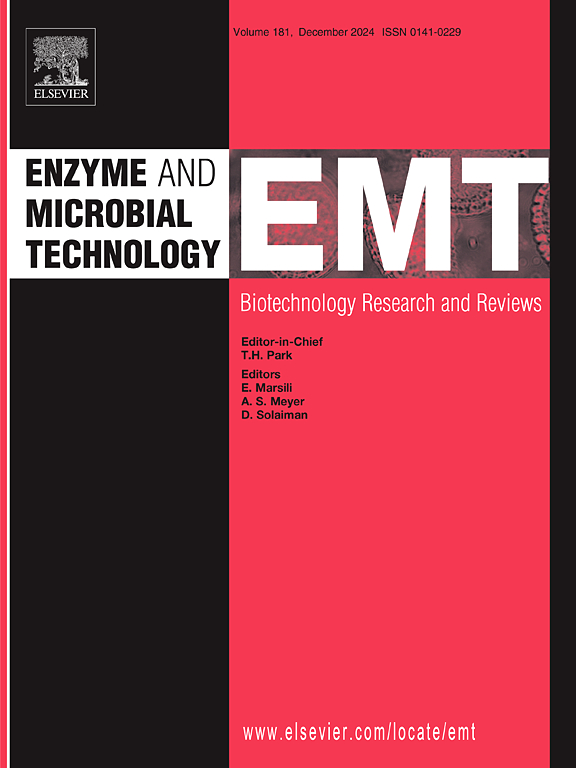Deciphering key residues governing thermostability in Thermomyces lanuginosus lipase through Gibbs free energy-guided engineering
IF 3.7
3区 生物学
Q2 BIOTECHNOLOGY & APPLIED MICROBIOLOGY
引用次数: 0
Abstract
Lipases serve as indispensable biocatalysts in many industrial applications due to their versatile catalytic abilities. To ensure their thermal resilience of the harsh biological treatment in industry, it is crucial to identify key residues which might impact thermostability. Here, computational design was adopted to decode the stability-determining residues in Thermomyces lanuginosus lipase (TLL). Systematic Gibbs free energy profiling of potent TLL single-point mutational candidates predicted proline 256 (P256) as a thermal liability hotspot. Saturation mutagenesis at P256 discovered that among nineteen P256 variants: (1) five P256 variants exhibited increased melting temperature (ΔTm up to 2°C); (2) six variants displayed an optimum temperature with 5–10°C elevation; (3) five P256 variants retained up to 21 % higher residual activity after incubation at 80°C. Furthermore, both P256E and P256I demonstrated synergistic improvements in biodiesel conversion rates, P256I specifically exhibited long-term and recycling stability. Molecular dynamics simulations revealed that the substitutions in P256A/E/I/K with compensatory main-chain rotational freedom, facilitating hydrogen bonding network with both upstream and downstream residues, thereby preserving local structural stability. This study pioneers the identification of P256 as a critical residue governing TLL thermostability. Furthermore, our Gibbs-guided engineering strategy generates multi-property-enhanced lipase variants, directly addressing industrial demands.
吉布斯自由能引导工程解译热酵母菌脂肪酶热稳定性关键残基
由于脂肪酶具有多种催化能力,在许多工业应用中是不可缺少的生物催化剂。为了确保其在工业中苛刻的生物处理中的热弹性,确定可能影响热稳定性的关键残留物是至关重要的。本文采用计算设计方法对热酵母脂肪酶(thermoyces lanuginosus lipase, TLL)中决定稳定性的残基进行解码。强TLL单点突变候选体的系统吉布斯自由能谱预测脯氨酸256 (P256)是热倾向热点。P256的饱和诱变发现,在19个P256变异体中:(1)5个P256变异体的熔融温度升高(ΔTm高达2°C);(2) 6个突变体的最适温度为海拔5 ~ 10℃;(3)在80°C孵育后,5个P256变体的残留活性提高了21% %。此外,P256E和P256I均表现出协同提高生物柴油转化率的能力,其中P256I表现出长期和循环利用的稳定性。分子动力学模拟表明,P256A/E/I/K的取代具有补偿的主链旋转自由,促进了上游和下游残基的氢键网络,从而保持了局部结构的稳定性。这项研究率先确定了P256作为控制TLL热稳定性的关键残留物。此外,我们的吉布斯指导工程策略产生多属性增强的脂肪酶变体,直接解决工业需求。
本文章由计算机程序翻译,如有差异,请以英文原文为准。
求助全文
约1分钟内获得全文
求助全文
来源期刊

Enzyme and Microbial Technology
生物-生物工程与应用微生物
CiteScore
7.60
自引率
5.90%
发文量
142
审稿时长
38 days
期刊介绍:
Enzyme and Microbial Technology is an international, peer-reviewed journal publishing original research and reviews, of biotechnological significance and novelty, on basic and applied aspects of the science and technology of processes involving the use of enzymes, micro-organisms, animal cells and plant cells.
We especially encourage submissions on:
Biocatalysis and the use of Directed Evolution in Synthetic Biology and Biotechnology
Biotechnological Production of New Bioactive Molecules, Biomaterials, Biopharmaceuticals, and Biofuels
New Imaging Techniques and Biosensors, especially as applicable to Healthcare and Systems Biology
New Biotechnological Approaches in Genomics, Proteomics and Metabolomics
Metabolic Engineering, Biomolecular Engineering and Nanobiotechnology
Manuscripts which report isolation, purification, immobilization or utilization of organisms or enzymes which are already well-described in the literature are not suitable for publication in EMT, unless their primary purpose is to report significant new findings or approaches which are of broad biotechnological importance. Similarly, manuscripts which report optimization studies on well-established processes are inappropriate. EMT does not accept papers dealing with mathematical modeling unless they report significant, new experimental data.
 求助内容:
求助内容: 应助结果提醒方式:
应助结果提醒方式:


